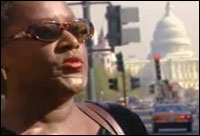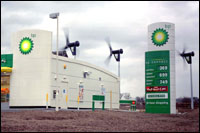Last month, 10 solar-powered race cars zipped around a 1.5-mile NASCAR track at the legendary Texas Motor Speedway, some of them reaching the dizzying speed of 35 miles per hour. With all its technological novelty and timely political implications, the Dell and Winston Solar Challenge (named for the computer and cigarette companies that sponsored it) might have been a grand public spectacle. But the entire 155,000-seat stadium was empty. Apparently, the sweeping historical significance of solar power was lost on the NASCAR and monster-truck crowd that normally flocks to this Fort Worth hotspot — much as it still seems to elude the rest of mainstream America.

Burning it up at the Solar Challenge.
Photo: Dell-Winston Solar Challenge.
The event was oddly reminiscent of America’s first auto race in 1896, where the competing “horseless carriages” reached a maximum speed of five miles per hour and a lone agitator in the stands cried out, “Get a horse!” Within decades of this rebuke, the automobile industry had seen stratospheric growth. Although solar-powered cars aren’t likely to become viable (much less commercially successful) anytime soon, the solar industry itself is poised for significant growth over the next several decades, and the implications for mainstream America could be as immense and far-reaching as those of the Model-T.
As environmental writer Bill McKibben pointed out in a recent piece in Mother Jones, “Renewable energy is no longer the stuff of noble visions and pipe dreams: It’s available, inexpensive and increasingly normal.” But, he laments, “The gap between what we could be doing and what we are doing has never been wider.” While new developments abound, McKibben says, the feds have done squat to encourage them in the marketplace, and consumers have been slow on the uptake.
Some of this gap can be blamed on the Bush administration, which has failed to aggressively promote alternative-energy solutions in the face of escalating global conflicts that are threatening our fossil fuel supplies. But even with federal support, the clean energy industry would have another issue to contend with — a different kind of issue, the kind that would get whispered about at a Madison Avenue cocktail party if someone walked in with overalls, a tie-dyed T-shirt, and a bad case of B.O: major image problem. The truth is, clean energy has about as much sex appeal as a Rainbow Planet catalogue.

Stuck on the fringe.
“Mainstream consumers simply aren’t turned on by an industry associated with smiling suns, glittering purple-panel roofscapes, and purist, hippy-dippy lifestyles,” scoffs Amely Greeven, a marketing consultant currently working on campaigns for Nike, Gucci, and Yves Saint Laurent. “Like it or not, the face of ‘green’ needs a makeover. It needs a marketing strategy that’s edgy and of-the-moment, rather than lost in a ’70s sensibility. Young celebrity spokespeople, for one thing, could go a long way to push this fringe movement into the mainstream.”
She has a point. The clean energy movement has shown steady progress in the marketplace — the solar and wind industries have grown nearly 40 percent per year for the last four consecutive years — but still solar and wind combined account for less than 1 percent of the nation’s electricity production. This is partly because renewables are still more expensive than traditional energy sources, but partly because mainstream consumers still haven’t been convinced of their advantages. And although multitudes of energy experts are spreading the renewables gospel with a steady stream of op-eds calling for better solar and wind subsidies, better fuel-efficiency regulations, and better conservation plans in the name of energy independence and environmental security, to a large degree they are preaching to the converted. It’s really up to the trendsetters to persuade the rest of America — to show the rising generations of voters and consumers that, like navel rings and Nirvana, the alternative energy movement is just alternative enough to go mainstream.
The Word on the Street
The good news is that some people are beginning to catch on to this golden marketing opportunity. In June, British Petroleum (aka “Beyond Petroleum”) launched America’s first high-profile, high-concept, mega-bucks clean energy campaign — their biggest U.S. campaign ever in terms of cost and distribution. BP, which is America’s largest supplier of oil and natural gas, is also the world’s third-largest solar producer, the leader among a surprising number of traditional energy companies that are beginning to diversify into clean technologies. “Given the escalating symptoms of global warming and widespread distrust of the energy industry, the time is right to show that we are the energy market leader who is addressing these concerns head-on,” says Dave Welch, BP’s director of U.S. advertising.

A still from the “BP on the Street”
campaign.
Photo: BP.
Dubbed “BP on the Street,” the new campaign borrows from the reality-programming phenomenon, featuring candid interviews with hip, straight-shooting urbanites who are invited to air their grievances about the energy industry. “Oil is old news. It’s time for a new era. It’s time for new technologies,” reads the quote below a candid snapshot of Fumi Bankole, a beautiful, young math teacher who appears in the print campaign (running nationally in the New York Times, New Yorker, Newsweek, and Time). In a TV campaign running in major U.S. cities, a striking African-American woman is asked what she would say to an oil company executive. Her answer: “Think about your children. They’re breathing the air I’m breathing, that you’re breathing, and it’s bad. And down the line, they will suffer. And you know, think about that. You know, if you have alternatives, invest the money in alternatives. You’ll still make money. It won’t make you a Communist. It’ll just make you a better human being.”
In another TV spot, Henry Snee, a foxy college kid who looks like he just stepped out of Urban Outfitter, answers the same question: “‘Have a conscience.’ They have an obligation to the rest of the planet not to just pay attention to their bottom lines — to their profits. They have to think about what we’re doing to the world down the line.” Another kid who looks special-ordered from Seattle offers a conspiracy theory when asked if oil companies are forward-looking: “I think the technology’s there, and it’s been there, and they’re just not using it.”
Despite the hypocrisy inherent in a company that calls itself Beyond Petroleum while more than 99.5 percent of its revenues are still oil- and gas-derived, both the ad campaign and the company itself are winning me over. Let’s look at the numbers: In the last six years, BP has invested $200 million in solar development, which is small change compared to the billions it spent on fossil fuels during the same period, but enough to corner 20 percent of global marketshare in the budding solar industry. The company has also committed to investing another $300 million in new solar factories by 2004 and pledged to grow its solar business to $1 billion by 2007. BP has predicted that renewable energy sources, which currently account for less than one-half of 1 percent of America’s energy production, will account for a staggering 50 percent of world production by 2050.

A BP station in the U.K. that runs on
renewables.
Photo: BP.
Statements like these inevitably raise the concern that they are, in fact, just statements. But BP has already proven that it’s no slouch when it comes to meeting its public goals. Lord John Browne, CEO of BP, was the first energy executive to publicly address the global warming challenge in 1997, when he committed his company to reducing its greenhouse emissions 25 percent below 1990 levels by 2010. BP reached that goal last October — eight years early — and has since raised the bar on its reductions goals and made efforts to spread the word. In response, other energy companies including Shell and ChevronTexaco have stepped up to the plate with public climate initiatives and investments in the solar, wind, and fuel cell industries. (In the last year, Shell purchased Seimen’s Solar to become one of the world’s top solar producers.)
I’d argue that BP’s greatest contribution to the clean energy movement hasn’t been its 20 percent marketshare in the solar industry, or even its 25 percent reduction of greenhouse gasses, but rather its flair for publicity. Hopefully, whatever greenwashing BP perpetrates to capture the public’s attention and encourage debate will, in the long run, only force the company to become all the more accountable to its claims.
John Seifert, managing partner of the advertising firm Ogilvy and Mather, has been in charge of the BP account since it made the “Beyond Petroleum” shift in 1997. “Lord Browne came to me with a dream proposal. He said, ‘I want this company to be a force for good in this world. Build that image and I will hold the company accountable to it,'” Seifer recalls, as though it was a divine visitation. But the campaign, says Seiford, was bedeviled by a “central paradox”: “No other industry is more loathed and distrusted by the public than the energy industry, and yet no other industry is more critical to modern survival. The reality is that no matter how much consumers resent energy companies, they still drive their cars and leave on the lights and turn the other cheek.” What could be edgier than a campaign that puts the entire industry on public trial — that, as Seiford put it, “bridges the us/them barrier, that brings the consumer into the debate so that we can address the problem together”?
“It’s a landmark campaign,” says Toby Barlow, an advertising creative director who has worked on campaigns for companies ranging from Saturn cars to Absolut Vodka. “My hope is that BP’s appetite for good PR will jumpstart the solar market — that every energy company will start competing against one another to see who can be more green.”
Out on a Limbaugh
Barlow, for his part, is also making efforts to feed the greening frenzy. He’s now working to organize a consortium of solar manufacturers to launch America’s first national solar campaign. He won’t disclose any details about what the ads will look like, but says they’ll be “cool and intuitive rather than dry and rational — something that provokes quick emotional recognition.” The consortium is similar to the group of dairy producers that created the “Got Milk?” campaign, and the ads could be similar as well: “Got Sun?” Instead of celebrities sporting that oddly post-coital creamy mustache, they could be talking on solar-powered cell phones, typing on solar-powered laptops, camping in solar-powered tents, or lounging in a solar-powered Jacuzzi. The ad could include irresistible cocktail party facts such as “America’s entire electricity demand could be generated by a swath of solar panels spanning 90 square miles,” or political factoids promoting a consumer revolution: “If 15 percent of average American households were solar-powered, our nation would cut its greenhouse-gas emissions by twice as much as proposed in the Kyoto Protocol on climate change.”

The future’s so bright.
Photo: NREL / Stellar Sun Shop.
Barlow winces at the “Got Milk?” concept, which has been ripped off by just about every spoof ad under the sun, but says he’s “not above exploiting supermodels to save the world” and hardly averse to bells and whistles. In fact, he’s been working with a graphics specialist at Imaginary Forces, the special effects company that did the titles for Spiderman, to create animated shorts promoting Votesolar.org, the organization that helped convince San Francisco voters to approve a $100 million investment in renewable energy last year. Now, as VoteSolar.org begins to organize similar initiatives in cities nationwide, Barlow is scrambling to arrange funding to launch the ad campaign. He’s also applying for money to run radio ads during rush hour, so that commuters who are stuck in traffic, feeling mild pangs of guilt over their giant SUVs, can ponder the alternatives.
“If I had the money, I’d pay Howard Stern to put solar on his house and talk about how he’s sick of paying electric bills to Con Ed and now he’s got his own rooftop power plant. It’s the kind of rebellious thing I can see him doing and it would have tremendous impact. Much more so than having Ralph Nadar talk about solar. Then again, it might be fun to use Ralph if we could find someone cool to use as a counterpoint. I heard that Rush Limbaugh has been doing some radio shows about solar, so maybe we photograph them together: Rush and Ralph agree,” says Barlow, “Maybe we could throw Stern in the middle.”
And maybe Dell and Winston could enlist Dale Earnhardt, Jr., to host the next solar-powered car race. While they’re at it, they might even consider throwing in some cross-platform marketing: “Solar racing could be perfect,” says marketing guru Greeven, “as a novelty event in MTV’s X Games.”
